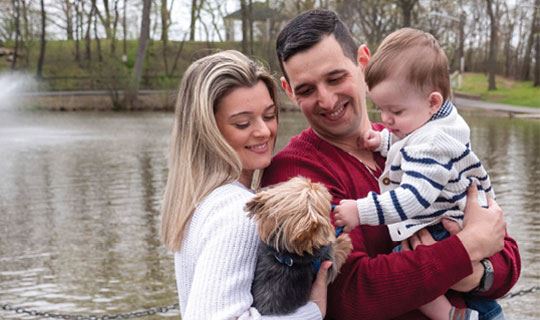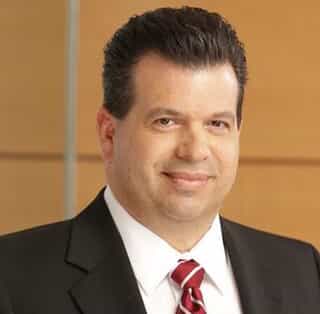“Nothing stops Liam,” says Matt. “If he wants a toy that’s not within reach, he’ll do whatever it takes to get it.”

Complex surgery and treatment save a baby born with internal organs outside his body.
Carla Vaz, 34, was 12 weeks into her pregnancy when a technician took a routine ultrasound scan at a prenatal visit. After the doctor reviewed it, she told Carla and her husband, Matthew De Oliveira, 37, that the scan had revealed an issue. The baby had an omphalocele (pronounced um-fa-lo-seal).
“We were clueless. We had no idea what she was talking about,” Carla remembers. Soon enough, they learned that an omphalocele is a birth defect of the abdominal wall in which the infant’s intestines, liver or other organs protrude outside the abdomen through the belly button, contained in a thin membrane sac. It’s a rare condition—about one in 4,200 U.S. babies is born with it—and the cause is unknown.
Babies born with an omphalocele often have additional problems, such as heart defects, chromosomal abnormalities and damage to organs. “The doctor told us there were a lot of tests we could do to find out if there were other issues,” Carla says.
The couple went back to the Newark home they share with Matt’s parents and gave them the news. “There were a lot of tears,” Matt says. The family went through the holidays waiting for test results, the last of which came in mid-January.
The baby’s omphalocele was classified as “large,” and his liver and gallbladder were outside the body; his stomach hadn’t fully closed. “But after all the other tests, they found there was nothing else wrong with the baby,” Carla says. “His only problem was the omphalocele.”
A Complex Surgery
Carla and Matt were referred to Christopher A. Gitzelmann, MD, Chief of Pediatric Surgery at Saint Barnabas Medical Center (SBMC) for a prenatal consult. Dr. Gitzelmann specializes in the reconstruction of congenital (present at birth) malformations of the newborn.

“These surgeries need to be very precise because we only get one shot at getting them right, and then it needs to last a lifetime,” Dr. Gitzelmann says.
“By the time I meet parents, they have been Googling the word they’ve been given, and unfortunately they often find examples of cases that have not gone very well,” Dr. Gitzelmann says. “I sit with them and go through the entire sequence of why this defect has occurred, make a drawing of the anatomy for them and give them a general idea of what procedure may be necessary. It calms them down to have a clearer understanding.”
No outcome, of course, is a given. “I’ve been a pediatric surgeon for more than 20 years and can handle very complex things and different variances in a case,” Dr. Gitzelmann says. “But there are limitations in medicine about what can be accomplished, and we have to be open and honest about that.”
Intestinal Obstructions
After an emergency C-section because the sac around the omphalocele had ruptured, Liam Vaz De Oliveira came into the world on March 29, 2020, weighing 6 pounds, 11 ounces.
“Liam’s organs were open to the environment, so we placed a dome-shaped VAC [vacuum-assisted closure] dressing, a foam barrier with a cellophane-like wrapping, to temporarily cover the opening,” Dr. Gitzelmann explains. “It also keeps the opening clean by sucking out fluids and bacteria.”
Two days later, in a second procedure, Dr. Gitzelmann discovered that Liam had atresias—complete obstructions of the intestine—in six separate locations. “Atresias lead to the intestine not being in continuity, and therefore the baby cannot eat,” he explains. “Due to these circumstances, the intestine was too short—less than half as long as it should have been.” It was an extraordinary case.
Over the course of several subsequent procedures, Dr. Gitzelmann sutured all the sections of the intestine back together. “In the first months of a baby’s life, tissues are still able to regenerate. We were trying to make the intestine grow on its own,” he says.
Nutrients stimulate growth, but the only way Liam’s intestine could access nutrients at this point was to be “fed” through a catheter (a thin tube) threaded through an ostomy (a hole created by a surgeon). The Neonatal Intensive Care Unit (NICU) team at SBMC also provided total parenteral nutrition (TPN), which gives nutrients through veins when the intestine is not functioning. These treatments went on for nearly six months, during which time Liam’s intestine grew in length and the disconnected segments slowly grew together.
Meanwhile, Liam’s VAC dressing was changed twice a week. “Because the VAC dressing has some suction, it begins to pull the edges of the opening together,” Dr. Gitzelmann explains. “Every time we changed the dressing, the organs were gently pushed back inside the abdomen and the skin was pulled a little tighter.”
Home At Last
 During these months, Carla and Matt were daily visitors to the NICU, where Liam was under the care of neonatal and perinatal medicine specialist Hyejin Lee, DO.
During these months, Carla and Matt were daily visitors to the NICU, where Liam was under the care of neonatal and perinatal medicine specialist Hyejin Lee, DO.
Three weeks after Liam was born, Carla and Matt were able to hold him. “We finally got to kiss his little head,” Matt recalls. “Liam showed us his personality right from the start,” Carla says. “He was a happy, smiley baby, and that helped us be able to go home and sleep at night.”
Carla pumped breast milk and brought it to the NICU. As Liam’s intestines healed and grew, procedures were performed to reconnect segments of intestine. Liam was able to take ever-increasing amounts with a bottle.
After almost eight months, Liam’s intestine was able to absorb all the necessary nutrients, enabling him to grow and thrive. In early November, Carla and Matt got the call that they could bring Liam home. Matt recalls how the baby’s eyes widened in wonder as he saw an environment outside the NICU for the first time.
Liam will need more procedures as he grows, but today, he is a happy toddler. “There is no bigger reward than seeing these kids come back to us in clinic and seeing that our plan has worked out just as we wanted it to,” says Dr. Gitzelmann.
“We have a great team, both in our range of pediatric surgery specialties and in the NICU. Though these babies have some of the most complex conditions they could have, we can handle them right here at Saint Barnabas Medical Center.”
Meet Dr. Christopher Gitzelmann
Learn more about pediatric specialties at Saint Barnabas Medical Center or call 973-322-6900.